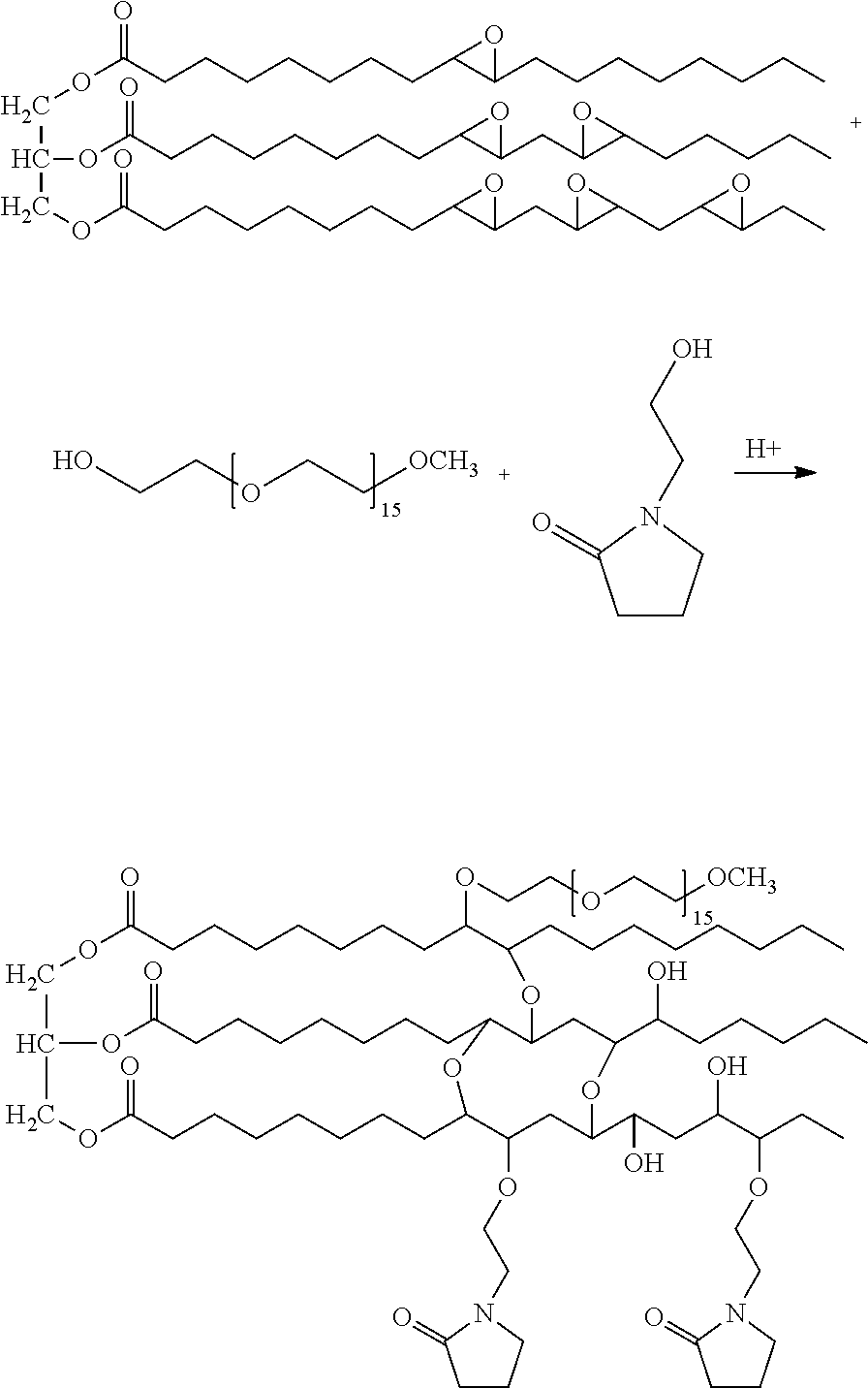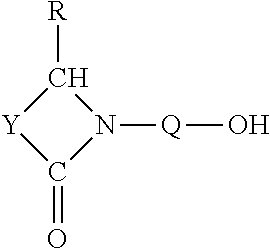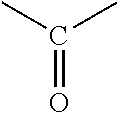Renewable modified natural compounds
- Summary
- Abstract
- Description
- Claims
- Application Information
AI Technical Summary
Benefits of technology
Problems solved by technology
Method used
Image
Examples
example 1
1 Molar Eq. ESO Opened with 3.0 Molar Eq. HEP
[0266]
[0267]A 500 mL, 4-neck, round-bottom flask was fitted with a mechanical mixer, oil bath with temperature controller, thermometer and bubbler gas outlet. The flask was charged with 9.7 g (0.075 mol.) hydroxyethyl pyrrolidone (HEP) and 1.0 mL tetrafluoroboric acid catalyst (50% aqueous solution). Mixing and heating of the reaction in the hot oil bath (set point=115° C.) was initiated. Epoxidized soybean oil (ESO) (Paraplex® G-60; The Hallstar Company; Chicago, Ill.) (28.83 g, 0.025 mol.) was added over 30 minutes in three shots: 10.0 g at t=0 minutes at a temperature of about 98° C., 9.0 g at t=15 minutes, and 10.0 g at t=30 minutes. The reaction was monitored for HEP level by GC (13.6 min) and epoxide ring depletion was detected by FT-IR (825-835 cm−1). The reaction was completed 10.5 hours following the third ESO addition. The crude reaction product, a clear, amber-gold oil, was cooled to room temperature, and then dichloromethane o...
example 2
1 Molar Eq. ESO Opened with 2 Molar Eq. HEP
[0269]
[0270]A 1000 mL, 4-neck, round-bottom flask was fitted with a mechanical mixer, oil bath with temperature controller, thermometer and bubbler gas outlet. The flask was charged with epoxidized soybean oil (ESO) (Paraplee G-60; The Hallstar Company; Chicago, Ill.) (28.83 g, 0.025 mol.). Mixing and heating of the reaction in the hot oil bath (set point=112° C.) was initiated. A quantity of 6.46 g (0.05 mol) of hydroxyethyl pyrrolidone (HEP) and 1.0 mL tetrafluoroboric acid catalyst were combined and added in three equal amounts after t=0, 10, and 15 minutes at about 98° C. reaction temperature. The reaction was monitored for HEP level by GC (13.6 min) and epoxide ring depletion was detected by FT-IR (825-835 cm−1). Then, 1 mL of tetrafluoroboric acid was added 4 hours after the third HEP / tetrafluoroboric acid addition. The reaction was considered complete 10.5 hours after the third ESO addition. The crude reaction product, a clear, amber...
example 3
1 Molar Eq. ESO Opened with 3 Molar Eq. HEP in Toluene
[0271]
[0272]A 500 mL, 4-neck, round-bottom flask was fitted with a mechanical mixer, oil bath with controller, thermometer and reflux condenser. The flask was charged with epoxidized soybean oil (ESO) (Paraplex® G-60; The Hallstar Company; Chicago, Ill.) (29.0 g, 0.025 mol) dissolved in 90.0 g of toluene. In this Example the reaction was performed in refluxing toluene. Mixing and heating of the solution in the hot oil bath (set point=140° C.) were initiated. Hydroxyethyl pyrrolidone (HEP) (9.7 g, 0.0500 mol) and 1.0 mL tetrafluoroboric acid catalyst were combined, and added over 15 minutes in three equal amount at t=0, 10, and 15 minutes at about 98° C. reaction temperature. The reaction samples were monitored for HEP level by GC (13.6 min.) and epoxide ring depletion was detected by FT-IR (825-835 cm−1). A second 1.0 mL of tetrafluoroboric acid was added 4 hours after the third HEP / tetrafluoroboric acid addition. The reaction wa...
PUM
 Login to View More
Login to View More Abstract
Description
Claims
Application Information
 Login to View More
Login to View More - R&D
- Intellectual Property
- Life Sciences
- Materials
- Tech Scout
- Unparalleled Data Quality
- Higher Quality Content
- 60% Fewer Hallucinations
Browse by: Latest US Patents, China's latest patents, Technical Efficacy Thesaurus, Application Domain, Technology Topic, Popular Technical Reports.
© 2025 PatSnap. All rights reserved.Legal|Privacy policy|Modern Slavery Act Transparency Statement|Sitemap|About US| Contact US: help@patsnap.com



